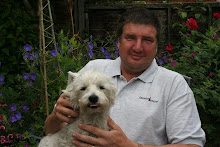 |
| There's always one. Houdini Duck is out AGAIN. |
There's always one, isn't there? Ours at present is one of the ducks who, unlike his 5 colleagues, is refusing to be contained by my attempts to ban ducks from the big pond. The 5 just went into the 'new' pen (the orchard) on the day we decided to move them, whinged for a while walking up and down the wire fence, but then settled down, uncomplaining, to a life with the geese. They may have tried to nip through the fence and the sheep hurdles a few times but when they couldn't break through at ground level, they relaxed and stayed put.
 |
I was trying to get a good "It's lashing down!" pic for 365.
I was happy with this one. |
Duck #6, though, had other ideas. Every time we ran the ducks into the orchard, you'd hear him a few minutes later quacking loudly in the yard or on the front drive. The escapes quickly earned him the name 'Houdini Duck' and we had to keep an eye on him to see how and where he was escaping. He's not that subtle, bless him, and brazenly escaped again while we watched. He had realised that while the bottom 'rungs' of a sheep hurdle were close together (to stop baby lambs), the gaps got bigger further up the hurdle, and if he hopped up to rung #3, he could squeeze through there.
 |
| We are getting some striking sunsets with all these storm clouds. |
I covered all the hurdles with 1" square 'aviary mesh' to stop his little game, but the lad sussed out that the same size changes also applied to the sheep wire as a whole. He could get out anywhere around the orchard perimeter with a simple hop up to a foot from the ground and a slither down through, but so far only does it nearest to the big pond. My next step is to run 2" chicken wire all along that fence line. This bizarre psychology is one of the good things we have learned about containing poultry. Chickens, for example, will happily fly up and over a 6 foot solid, opaque wall, but do not think they can do the same flight over a transparent, chicken wire fence. They walk up and down the fence looking through it and bumping off it with their beaks but it never seems to occur to them to fly up and over.
 |
They might look pretty in the slanting evening sunshine but
they are still thistles and need clearing |
Actually he is not a natural 'free bird' and does not do anything with his freedom. He seems rather upset that his 5 colleagues do not follow him and he hangs around sadly just outside the fence, quacking at them. He does not even go onto the pond much on his own, so the pond is, in fact, recovering slowly. He is, though, a nuisance (as well as an affront to my fencing ability!) so he needs to be contained by this next plan or he is going to find himself 'ate' if he doesn't watch out. I am talking 'He' here, of course. He may not turn out to be a drake but if he is and he is not the only one, then he may be first against the wall come the revolution. [I am hoping here that my readers know me well enough to know that all this may not be 100% serious. We do not, in fact, make 'harvesting' decisions based on how annoying the livestock are!].
 |
| Lamb |
In other harvesting stories, we were booked to nip down to our butcher in Castlerea on Monday to collect and see cut up, our two ram lambs, Ebony and Ivory. It is fascinating to talk to the lads down there and we wondered how our lambs would fare especially as the slaughterman always has a bit of a light hearted chunter at our lambs being too big or, sometimes being black-wooled and therefore less likely to grow as well. The guys have been at it for a long time, so they should know, but I have to admit to a bit of 'pinch of salt' at the 'black wool bad' thing.
 |
| First fruits for 2016. Some nice lamb chops for Monday supper. |
This time they were spot on - the white wool boy was definitely fatter and bigger. There is not a lot we can do about this, however. Our #2 ewe, Polly' is half 'Jacob', a bicoloured mountainy breed, which is almost certainly the reason for the black wool and less heavy shape of her lambs. What ever the case, we saved 4 chops from the freezer and had them as our 'first fruits' of 2016 meat. They were a tender and flavour-filled delight.
 |
| Thistles for the compost. |
The remaining 6 sheep are currently mowing my front lawn for me while I get a chance to nip round and pull the thistles in the East Field. After the rain, it is a good satisfying task as a vertical gentle pull will give you all the stem and leaves plus a good chunk of taproot. The field is not too bad because I do this every year - if you pull the root the sheep can straight way return to graze there. If you mow or cut the shoot and leave the top or any leaves still there, the sheep will avoid the grass and your thistle will just re-grow. I guess there are about 3-4 man hours of work at it and 3 towering wheel barrows of thistles for the compost.
 |
| The Hubbard poults spread out across their new paddock. |
My only other news is that the Hubbards, at 50 days old are now well settled into and enjoying their new run and have learned to take themselves off to bed in the correct place (in the coop not under it!) as it gets dark. . This was not an immediate thing and I had an abortive day when I'd got 9 of them in, all calm, when Blue the Cat decided to 'help'. That day I had to hire the 'assistant chicken wrangler' to help round up the upset, scattered poults and steer them back towards their (now cat-free) home for the night. It's never boring with livestock.










1 comment:
Good job you didn't end up with Muscovy's Matt they are impossible to keep in as they climb.
Post a Comment